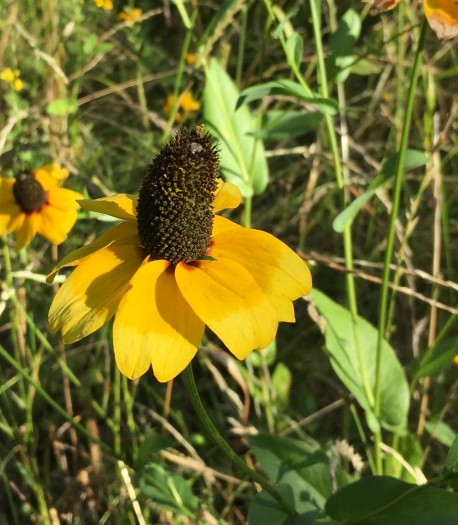Clasping Coneflower
(Rudbeckia amplexicaulis)
Clasping Coneflower (Rudbeckia amplexicaulis)
/
/

Brady Reed
Public Domain
Image By:
Brady Reed
Recorded By:
Copyright:
Public Domain
Copyright Notice:
Photo by: Brady Reed | License Type: Public Domain | License URL: http://creativecommons.org/publicdomain/zero/1.0/ | Rights Holder: Brady Reed | Publisher: iNaturalist | Date Created: 2017-04-23T13:49:27Z |























































Estimated Native Range
Summary
Rudbeckia amplexicaulis, commonly known as Clasping Coneflower, is an annual herb that is native to open prairies and disturbed areas in the South-Central United States. It typically grows to about 1 meter tall, with simple or branched stems. The leaves are distinctive, clasping the stem without a petiole, oval in shape, and measure 5–10 cm (2.0–3.9 in) long and 2–4 cm (0.79–1.57 in) broad. The flowers are produced in daisy-like inflorescences, with bright yellow to yellowish-purple florets that bloom from mid-summer to early fall. The flower heads are notable for their extended rays and central cones that are surrounded by bracts, or chaff, which is a characteristic that distinguishes it from other species in the Rudbeckia genus.
The Clasping Coneflower is valued for its vibrant flowers and ability to attract pollinators such as bees and butterflies, making it a popular choice for wildflower gardens, meadows, and as a border plant in sunny locations. It has earned the Royal Horticultural Society’s Award of Garden Merit for its performance in cultivation. This plant thrives in full sun and requires high amounts of water, preferring soils with medium drainage. While it is relatively low maintenance, it can suffer from powdery mildew or other fungal diseases in humid conditions. Deadheading spent flowers can encourage a longer blooming period and prevent excessive self-seeding.CC BY-SA 4.0
The Clasping Coneflower is valued for its vibrant flowers and ability to attract pollinators such as bees and butterflies, making it a popular choice for wildflower gardens, meadows, and as a border plant in sunny locations. It has earned the Royal Horticultural Society’s Award of Garden Merit for its performance in cultivation. This plant thrives in full sun and requires high amounts of water, preferring soils with medium drainage. While it is relatively low maintenance, it can suffer from powdery mildew or other fungal diseases in humid conditions. Deadheading spent flowers can encourage a longer blooming period and prevent excessive self-seeding.CC BY-SA 4.0
Plant Description
- Plant Type: Herb
- Height: 1.5-2.5 feet
- Width: 1-1.5 feet
- Growth Rate: Rapid
- Flower Color: Brown, Yellow
- Flowering Season: Summer
- Leaf Retention:
Growth Requirements
- Sun: Full Sun
- Water: High
- Drainage: Medium
Common Uses
Bee Garden, Bird Garden, Butterfly Garden, Deer Resistant, Drought Tolerant, Hummingbird Garden, Low Maintenance, Rabbit Resistant, Salt Tolerant, Showy Flowers
Natural Habitat
Open prairies and disturbed areas in the South-Central United States
Other Names
Common Names: Clasping-Leaf Coneflower, Stängelumfassender Sonnenhut, Draköga, 천인국아재비
Scientific Names: , Dracopis amplexicaulis, Rudbeckia amplexicaulis, Rudbeckia heterophylla, Rudbeckia spathulata,
GBIF Accepted Name: Rudbeckia amplexicaulis Vahl